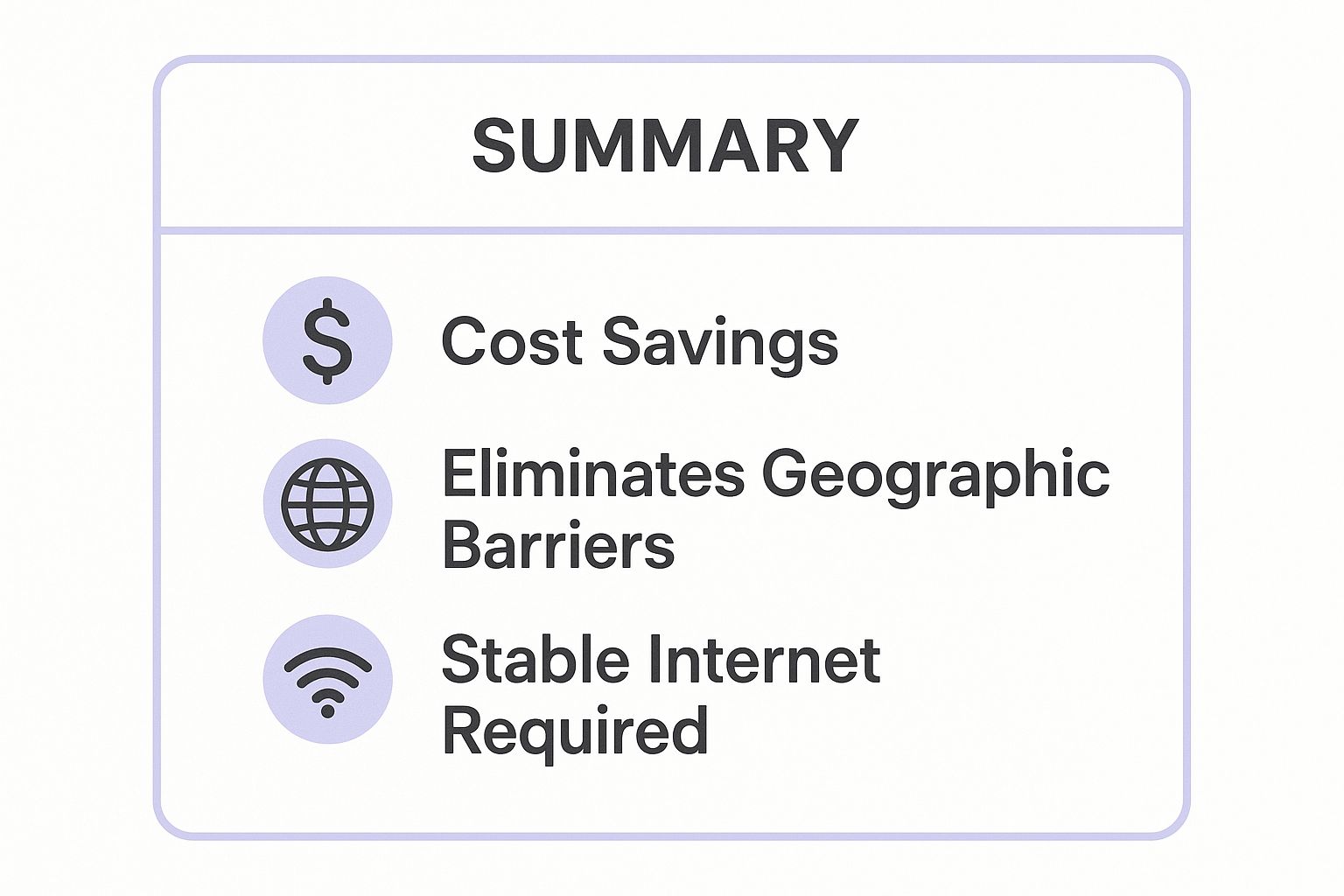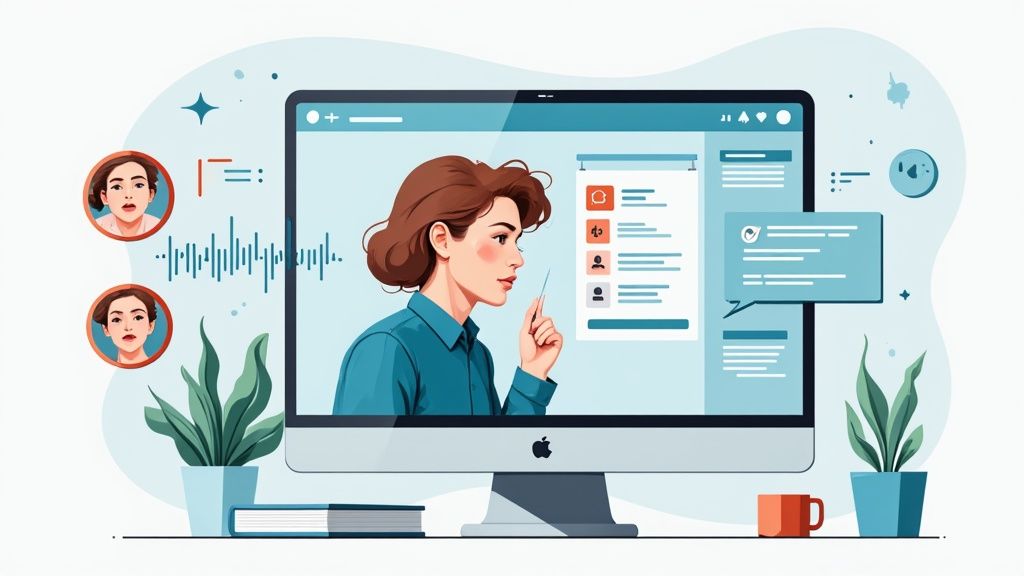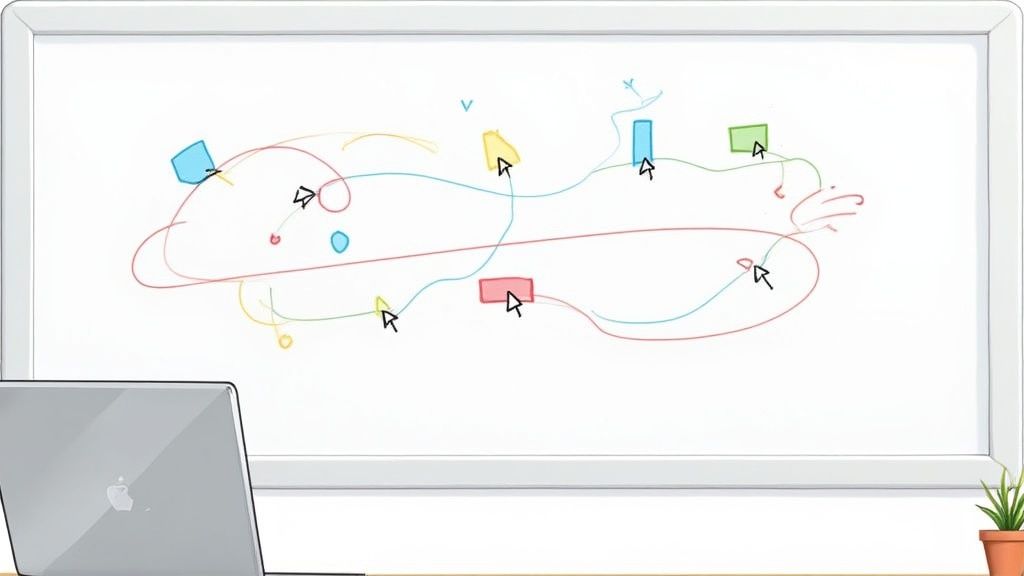
The world of hiring has transformed, and mastering virtual communication is no longer an optional skill. For both candidates and recruiters, the digital interview room has become the primary stage for first impressions and critical assessments. While the basics of online etiquette are well-trodden ground, the frontier of hiring technology is constantly advancing, introducing more sophisticated and effective online interview techniques. This guide moves beyond generic advice like "check your internet connection" and dives deep into seven advanced methods reshaping how top talent is identified and hired.
We'll explore everything from asynchronous video platforms to immersive virtual reality simulations, providing actionable insights, real-world examples, and expert tips to help you excel. Even the smallest details of your digital presence are now under scrutiny. As AI tools become more prevalent in recruitment, even your profile picture can be optimized, with modern platforms offering ways to create stunning AI headshots that project professionalism before you even speak a word.
Whether you're a hiring manager aiming to refine your recruitment process or a candidate determined to stand out, this comprehensive roundup will equip you with the knowledge to succeed. We will cover the specific strategies needed to master each technique, from collaborative whiteboard challenges to gamified assessments. By understanding these modern approaches, you can navigate the complex landscape of digital recruitment with confidence and secure the best possible outcomes.
The classic video interview is the cornerstone of modern online interview techniques, serving as the digital equivalent of a traditional face-to-face meeting. This real-time, synchronous conversation, facilitated by platforms like Zoom or Google Meet, allows for dynamic interaction between recruiters and candidates. Its primary goal is to bridge geographical distances, creating an opportunity for personal connection and comprehensive assessment that pre-recorded methods cannot match.
Success in this format extends beyond simply logging on. It demands a deliberate mastery of your digital presence. For both interviewers and candidates, this means treating the virtual meeting with the same rigor and professionalism as an in-person one. The technology should become an invisible conduit for communication, not a distraction.
To ensure the technology fades into the background, allowing for a genuine connection, focus on these three core areas:
Expert Insight: The most effective online interviews feel less like a technical process and more like a natural conversation. This is achieved when both parties proactively manage their environment and technology, a standard practice for companies like LatHire that regularly source elite talent from across Latin America.
The classic video interview is the most versatile and widely applicable of all online interview techniques. It is ideal for mid-to-late-stage interviews where establishing rapport and assessing personality fit are just as important as evaluating technical skills. For organizations building distributed teams, this method is essential for creating a human connection. Learn more about how to effectively conduct interviews with remote candidates from LatAm to perfect your approach.
This visual summary highlights the primary benefits and a key requirement for this interview format.

The infographic underscores that while video interviews significantly reduce costs and expand the talent pool globally, their success is fundamentally dependent on a reliable internet connection for both parties.
The asynchronous video interview, often called a one-way video interview, is a modern technique that decouples the interview process from real-time constraints. This method involves candidates recording video responses to pre-set questions on their own time, which recruiters and hiring managers can then review at their convenience. Platforms like HireVue, Spark Hire, and VidCruiter have popularized this approach, creating a time-shifted interview experience that prioritizes flexibility and efficiency.
Its core purpose is to streamline the initial screening phase, allowing companies to assess a high volume of applicants consistently and fairly. For candidates, it offers the chance to present themselves without the immediate pressure of a live conversation, while for companies, it standardizes the first-round evaluation. This technique represents a significant shift in online interview techniques, moving from synchronous dialogue to structured, independent assessment.
Success in an asynchronous interview hinges on preparation and presentation, as you don't have a live interviewer to build rapport with. Focus on delivering a polished and authentic performance:
Expert Insight: The asynchronous format is not just about evaluating answers; it’s about assessing a candidate's communication skills, poise, and preparedness. Global giants like L'Oréal and Vodafone use this technique in their graduate programs to identify candidates who can articulate their thoughts clearly and professionally under structured conditions.
The asynchronous video interview is exceptionally effective for high-volume, early-stage screening. It is ideal for roles where communication skills and initial qualifications are paramount, allowing hiring teams to efficiently sift through large applicant pools before dedicating time to live conversations. Companies like Goldman Sachs and Unilever have integrated it into their recruitment funnels to standardize initial assessments and reach a global talent pool across different time zones.
For organizations building large remote teams or running extensive graduate recruitment programs, this method is invaluable. It removes scheduling barriers, reduces unconscious bias by presenting every candidate with the exact same questions, and provides a scalable way to evaluate core competencies. This technique is a powerful tool for modern, large-scale talent acquisition.
AI-powered interview analysis represents a frontier in modern online interview techniques, augmenting human decision-making with data-driven insights. This advanced method uses artificial intelligence to analyze various aspects of a candidate's recorded or live interview, including speech patterns, emotional sentiment, keyword usage, and even non-verbal cues. The goal is not to replace human recruiters but to provide them with a deeper, more objective layer of information to identify top performers and reduce unconscious bias.
Platforms like HireVue and Pymetrics process vast amounts of data to find correlations between a candidate's responses and on-the-job success metrics. For instance, IBM's Watson Talent Analytics can assess personality traits from text, helping recruiters understand if a candidate's communication style aligns with company culture. This technology transforms the interview from a purely subjective conversation into a structured data point.

Successfully integrating AI requires a thoughtful and ethical approach. To harness its power while maintaining fairness and transparency, consider these core strategies:
Expert Insight: The true value of AI in recruitment is its ability to consistently and scalably identify job-relevant competencies that a human interviewer might miss. Companies using these tools are not just hiring faster; they are making more informed, data-backed talent decisions.
AI-powered analysis is most effective in high-volume recruiting scenarios where consistency and efficiency are paramount, such as entry-level roles or large-scale hiring initiatives at companies like Delta Airlines or JPMorgan. It helps standardize the initial screening process, allowing human recruiters to focus their time on the most promising candidates. To truly leverage data-driven insights, understanding the capabilities of the top video analytics software is crucial for implementation.
This technique is a powerful addition to a comprehensive evaluation process. By using it alongside other methods, organizations can build a more objective and predictive hiring model. Learn more about how these tools fit into a broader strategy by exploring various candidate assessment tools for modern recruitment.
The Virtual Reality (VR) interview is a cutting-edge online interview technique that transports candidates and interviewers into a shared, immersive digital environment. Leveraging VR headsets and platforms like Oculus for Business or HTC Vive, this method moves beyond the screen to create a three-dimensional space for interaction. Its core purpose is to facilitate hyper-realistic simulations, assess spatial and situational awareness, and capture nuanced non-verbal cues through avatar movements in ways 2D video cannot.
This futuristic approach is transforming recruitment for roles that require hands-on skills or complex problem-solving in a physical space. Companies like Walmart and Deutsche Bahn use VR to simulate real-world job scenarios, from managing a busy store floor to operating a train. The technology allows recruiters to evaluate how a candidate physically navigates challenges, collaborates in a simulated team environment, and reacts under pressure, offering predictive insights into on-the-job performance.
To deploy VR interviews effectively and avoid a disorienting experience, a focus on accessibility and technical support is crucial:
Expert Insight: VR is no longer just for gaming; it's a serious assessment tool. Pioneers like Strivr have demonstrated that immersive learning and evaluation can dramatically improve hiring accuracy for roles where spatial reasoning and physical task execution are paramount.
The VR interview is most impactful for highly specialized, technical, or customer-facing roles where practical skills are difficult to assess through conversation alone. It is ideal for engineering, architecture, healthcare, retail management, and complex machinery operation. Organizations like Lloyds Banking Group and Accenture use it to assess problem-solving and client interaction skills in a controlled, repeatable virtual setting.
This technique provides an unparalleled opportunity to evaluate a candidate’s applied skills and behavioral responses in a simulated work environment. While it requires a significant initial investment in technology and development, it can yield a high return by improving hiring accuracy and reducing long-term training costs.
The collaborative online whiteboard interview is a dynamic method that elevates online interview techniques by simulating a creative and problem-solving workspace. This interactive approach uses digital platforms like Miro or Mural to facilitate real-time collaboration on exercises, technical diagrams, and strategic planning. It moves beyond conversation, allowing recruiters and candidates to actively work together, mirroring the experience of brainstorming around a physical whiteboard while harnessing the efficiency of remote interaction.

Success in this format is about demonstrating how you think, not just what you know. It provides a transparent view of a candidate's problem-solving process, communication style, and ability to translate abstract ideas into visual concepts. For companies like Atlassian discussing software architecture or consulting firms like McKinsey running case studies, this technique is invaluable for assessing practical, on-the-job skills.
To transform the digital canvas into a powerful assessment tool, both parties should focus on clarity, preparation, and fluid interaction:
Expert Insight: The whiteboard interview reveals a candidate's ability to structure thoughts and collaborate under pressure. The most impressive candidates are those who can communicate their process clearly while actively building a solution, demonstrating both technical skill and excellent communication.
This technique is exceptionally effective for roles that require strong problem-solving, system design, creative thinking, or strategic planning skills. It is a staple in technical interviews for software engineers, product managers, and UX/UI designers. It is also highly effective for assessing marketers, consultants, and project managers who need to visualize workflows and strategies.
Using a shared digital space is fundamental to modern teamwork, especially in a remote setting. Mastering this format not only helps in the interview but also prepares candidates for the collaborative nature of distributed teams. Discover more about how to collaborate effectively with team members in different time zones to see these principles in action. This method effectively gauges a candidate's readiness for a truly collaborative remote environment.
The gamified assessment interview is an innovative online interview technique that transforms the evaluation process into an engaging and interactive experience. Instead of traditional Q&A formats, it uses game-based elements, challenges, and simulations to assess a candidate's cognitive abilities, problem-solving skills, and personality traits. This approach aims to create a more relaxed, pressure-free environment where candidates reveal their authentic behaviors and core competencies.
By embedding complex assessments within a game, companies can measure skills that are difficult to gauge through conversation alone, such as risk tolerance, strategic thinking, and learning agility. For example, Marriott's "My Marriott Hotel" game on Facebook allowed potential hospitality managers to simulate running a hotel, revealing their business acumen. Similarly, companies like Unilever and Shell have used neuroscience-based games from platforms like Pymetrics and Knack to identify key behavioral traits for success.
To effectively implement gamified assessments and ensure they provide meaningful data, focus on strategic alignment and a positive candidate experience:
Expert Insight: Gamification is most powerful when it stops feeling like a test and starts feeling like an enjoyable challenge. The goal is to observe natural problem-solving abilities, not to see who can "win" the game. This approach is pioneered by assessment companies like Arctic Shores and Pymetrics, who focus on capturing behavioral data over simple right-or-wrong answers.
This online interview technique is exceptionally well-suited for high-volume, top-of-funnel recruiting, particularly for early-career roles where candidates may lack extensive professional experience. It allows recruiters to efficiently screen thousands of applicants for underlying potential and cognitive fit. It is also highly effective for roles that demand specific soft skills like resilience, innovation, or strategic thinking, which are notoriously hard to evaluate in a standard interview. Companies aiming to enhance their employer brand and create a memorable, modern candidate experience will find this method invaluable.
The Mobile-First Interview Technique is a comprehensive strategy optimized specifically for mobile devices. It acknowledges the modern reality that a significant portion of candidates, particularly for high-volume roles, use smartphones as their primary tool for job searching and communication. This approach rethinks the entire interview process, from initial contact to final assessment, ensuring every touchpoint is accessible and user-friendly on a small screen.
This technique moves beyond simple mobile compatibility. It prioritizes the mobile experience by designing interactions natively for handheld devices, leveraging features like push notifications and simplified, thumb-friendly interfaces. Companies like Amazon, for warehouse roles, and Uber, for driver onboarding, have successfully used this to streamline hiring, reduce friction, and reach a wider, more diverse applicant pool that may not have consistent access to a desktop computer.
To effectively implement a mobile-first strategy, the focus must be on speed, simplicity, and accessibility. Consider these core areas for a seamless candidate experience:
Expert Insight: A true mobile-first approach is not just about making a desktop process usable on a phone; it's about redesigning the workflow from the ground up for the mobile context. The goal is to remove every possible barrier, making the application and interview process as easy as ordering a coffee, a principle expertly applied by platforms like Indeed Mobile and Glassdoor Mobile.
The mobile-first technique is one of the most effective online interview techniques for high-volume recruitment, especially for hourly, retail, or entry-level positions. It is indispensable when hiring for roles where candidates are often on the move or may not have access to a laptop, such as in logistics, food service, or the gig economy. Companies like Starbucks and McDonald's utilize this to rapidly screen thousands of applicants efficiently.
For any organization aiming to maximize its applicant pool and improve accessibility, this method is a powerful tool. It demonstrates a modern, candidate-centric approach that respects applicants' time and preferred communication methods, ultimately creating a more positive and efficient hiring cycle.
| Interview Technique | Implementation Complexity | Resource Requirements | Expected Outcomes | Ideal Use Cases | Key Advantages |
|---|---|---|---|---|---|
| Video Interview Technique | Moderate – requires setup and technical skills | Stable internet, video conferencing tools | Real-time interaction, recorded sessions | Remote interviews, panel discussions | Cost-effective, eliminates location barriers |
| Asynchronous Video Interview | Low to moderate – platform dependent | Video recording platform, stable internet | Flexible candidate responses, scalable | Screening large candidate pools, time-zone challenges | Flexible scheduling, reduces bias |
| AI-Powered Interview Analysis | High – needs advanced AI tools and integration | AI software, data processing infrastructure | Data-driven insights, bias reduction | High-volume hiring, objective assessments | Scalable, consistent, unbiased insights |
| Virtual Reality Interview | Very high – specialized hardware and software | VR headsets, development resources | Immersive experiences, realistic simulations | Technical skills, spatial reasoning, training | Engaging, skill-specific evaluation |
| Collaborative Online Whiteboard | Moderate – requires integrated collaboration tools | Digital whiteboard software, video platform | Interactive problem-solving, visual thinking | Technical interviews, design workshops | Promotes teamwork, documents thought processes |
| Gamified Assessment Interview | High – requires game design and analytics | Game development platforms, analytics tools | Behavioral insights, reduced anxiety | Cognitive testing, personality assessment | Engaging, objective performance metrics |
| Mobile-First Interview | Moderate – design and optimize for mobile UX | Mobile-optimized platforms, app support | Accessible interviews, quick communication | Hourly or gig workers, mobile-preferred candidates | Increases accessibility, leverages smartphones |
As we've explored, the landscape of recruitment has fundamentally transformed. Simply moving a traditional interview onto a video call is no longer sufficient to attract and secure top-tier global talent. The future of hiring isn't about choosing just one of the advanced methods we've covered; it's about strategically blending them to create a dynamic, multi-stage, and deeply insightful hiring process. This integrated approach is the cornerstone of modern, effective online interview techniques.
The journey from initial application to final offer should be a curated experience, designed to assess a holistic range of competencies. By moving beyond a single video call, you can build a comprehensive picture of each candidate, evaluating everything from their communication style and technical proficiency to their collaborative spirit and real-time problem-solving abilities.
Imagine a candidate journey that strategically deploys several of these powerful techniques. This isn't a futuristic fantasy; it's a practical blueprint for a superior hiring funnel that progressive companies are adopting today.
A potential integrated workflow could look like this:
Initial Engagement (Top of Funnel): The process begins with a Mobile-First Interview Technique, allowing candidates to apply and complete an initial screening easily from their smartphones. This is immediately followed by an Asynchronous Video Interview, where they answer a few pre-set questions on their own time. This combination respects the candidate's schedule, expands your talent pool globally, and uses technology to efficiently filter for baseline qualifications and communication skills.
Mid-Stage Assessment (Skills Validation): Promising candidates advance to a more rigorous evaluation. Here, you could deploy a Gamified Assessment to measure cognitive abilities or specific role-related skills in an engaging format. For technical roles, a Collaborative Online Whiteboard Interview is non-negotiable, providing direct insight into how a developer or engineer thinks, codes, and collaborates under pressure.
Finalist Stage (Deep Dive & Cultural Fit): The final candidates engage in a live, synchronous Video Interview with key team members and leadership. Throughout this entire process, AI-Powered Interview Analysis can be working in the background, providing objective data on communication patterns, sentiment, and keyword usage to help mitigate unconscious bias and support data-driven decision-making. For highly specialized or leadership roles, a Virtual Reality Interview could offer an immersive final-stage experience, assessing spatial awareness or situational leadership in a simulated environment.
Mastering these online interview techniques in isolation is valuable, but integrating them is a game-changer. This approach provides a significant competitive advantage for several key reasons:
Ultimately, the goal is to build a future-proof hiring strategy that is as sophisticated as the talent you seek to attract. By embracing this integrated model, you are not just filling roles; you are building the high-performing, resilient, and globally diverse teams required to innovate and lead in the years to come. Your recruitment process becomes a powerful signal of your company's culture: forward-thinking, fair, and focused on excellence. The time to build that future is now.
